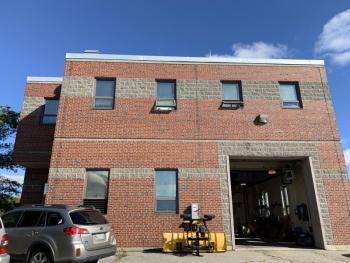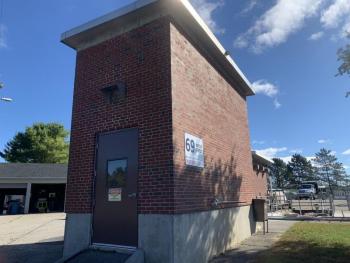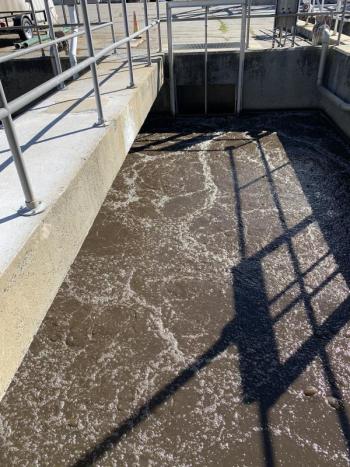Wiscasset, DEP in Q & A about sewer plant, sea rise
“Should we stay or should we go?”
Wiscasset Wastewater Superintendent Rob Lalli said Sept. 29, the options of building a wall and taking other steps, versus moving the plant – and, if so, where, at what cost, and how much government aid there might be for either option – are questions Wiscasset, like some other towns with plants along the water, will weigh when adapting their sewer plants for sea level rise. And he said the climate adaptation plan (CAP) for Wiscasset’s wastewater systems will help inform the town’s decisions.
At Wiscasset Newspaper’s request, Lalli shared the draft CAP and the questions and answers the DEP and town contractor Olver Associates have emailed each other.
The draft CAP’s executive summary states the system – with about 15 miles of sewers, 18 pump stations and the treatment plant – is resilient to drought, temperature changes and high winds. Flooding “from predicted rising water levels received the most consideration in this plan,” the Winterport firm writes. “The primary risk ... is flooding the equipment and structures ...” including manholes, buildings, a utility pole and backup generator.
The draft CAP proposes watertight, gasketed and bolted down manhole covers; demolishing the plant’s headworks building and others and building their replacements higher; heightening the walls in parts of the plant; raising the whole plant with fill; studying the concrete foundations to make sure they can withstand the taller walls; and studying structures’ buoyancy.
“It may be possible to erect a flood proof retaining wall around the entire perimeter of the site with a floodgate at the entrance ... An alternative is to relocate (the plant)” to a higher site, the firm continues.
According to the draft report, upgrading the plant and making it resilient has been projected to cost $20,945,000; moving it to Federal Street, $35 million; or to Mason Station, $44 million. “Should a decision be made to relocate the ... infrastructure to a new site, resiliency would need to be incorporated into that facility,” the draft report adds.
What does Lalli think the town should do? He is fine with whatever call the town makes, he said. He explained, DEP cannot require the town to move the plant, but it does license the plant.
Among department heads’ August reports the town released Sept. 15 is Lalli’s that notes some of DEP’s questions about the CAP. In that monthly report, he tells selectmen, “I can’t help this feeling that the DEP is nudging Wiscasset Sewer Department toward moving the plant.” Sept. 21, Wiscasset Newspaper emailed DEP that page of Lalli’s report and requested comment on Lalli’s “nudging” statement. No response was received as of press time Oct. 4.
Asked about his statement, Lalli explained it was to give selectmen a heads up, based on the kinds of questions DEP was asking.
In an Aug. 25 email, Karen Hefler of DEP’s water quality bureau tells Olver Associates President William Olver she has concerns about staff’s access to the plant in a flood. The railroad tracks there “severely limit (how that) could be rectified,” she writes. The tracks would also be a concern for the perimeter wall; so would suitable soils for the wall to be stable, Hefler adds. She suggests maybe increasing structures’ resiliency instead.
Olver responds Sept. 6, telling Hefler the plant’s staff would not be expected to drive into the site in a flood. “The interior of the site will be protected by the CAP measures such that staff can remain at the plant to keep it operational. Access to the plant may require use of the town’s Fire Department boat to reach the perimeter wall” which could be accessed by a ladder or stairs, and then staff can remain in the plant site for the event’s duration, Olver writes.
“While this is certainly more inconvenient than having a treatment facility on higher ground where vehicle access is continuous at all times, the proposed approach is simply being more pragmatic based upon the estimated costs of $35.0 to $44.0 million ... to relocate the plant,” Olver continues.
As for the soils issue, Olver states shallow ledge underlies the whole site, and some of the concrete foundations are as thick as 2.5 feet. “We have no concerns about soil conditions or existing foundations limiting the ability to raise reactor walls for flood protection.”
In a Sept. 12 email response to Olver, Hefler’s requests include having the CAP discuss the challenges of plant access, and for Olver “to clarify that the seawall is definitely possible.” She also poses a new question based on other DEP staff’s look at the draft CAP: In the several years it could be before the plant has been upgraded or moved, “How should the Town improve resiliency at the existing plant in the meantime?”
Olver responds Sept. 25 with floodplain maps Hefler requested, and new or updated sections in the draft to cover plant access, the perimeter wall being possible, and the capacity for reactors’ walls to be raised. Addressing the new question of how to up resiliency before the long-term changes happen, Olver tells Hefler “several measures to protect the existing facilities in the interim period have been added,” among them, placing the generator higher, installing watertight covers on low-lying manholes and vault structures “and keeping filled sandbags onsite to place against the doors” of lower buildings.
Lalli expected the updated CAP draft to go to DEP on Monday, Oct. 3.
































